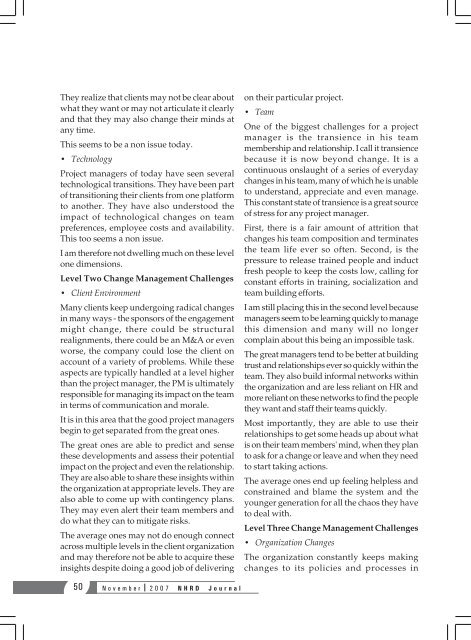NHRD Journal - National HRD Network
NHRD Journal - National HRD Network
NHRD Journal - National HRD Network
Create successful ePaper yourself
Turn your PDF publications into a flip-book with our unique Google optimized e-Paper software.
They realize that clients may not be clear about<br />
what they want or may not articulate it clearly<br />
and that they may also change their minds at<br />
any time.<br />
This seems to be a non issue today.<br />
• Technology<br />
Project managers of today have seen several<br />
technological transitions. They have been part<br />
of transitioning their clients from one platform<br />
to another. They have also understood the<br />
impact of technological changes on team<br />
preferences, employee costs and availability.<br />
This too seems a non issue.<br />
I am therefore not dwelling much on these level<br />
one dimensions.<br />
Level Two Change Management Challenges<br />
• Client Environment<br />
Many clients keep undergoing radical changes<br />
in many ways - the sponsors of the engagement<br />
might change, there could be structural<br />
realignments, there could be an M&A or even<br />
worse, the company could lose the client on<br />
account of a variety of problems. While these<br />
aspects are typically handled at a level higher<br />
than the project manager, the PM is ultimately<br />
responsible for managing its impact on the team<br />
in terms of communication and morale.<br />
It is in this area that the good project managers<br />
begin to get separated from the great ones.<br />
The great ones are able to predict and sense<br />
these developments and assess their potential<br />
impact on the project and even the relationship.<br />
They are also able to share these insights within<br />
the organization at appropriate levels. They are<br />
also able to come up with contingency plans.<br />
They may even alert their team members and<br />
do what they can to mitigate risks.<br />
The average ones may not do enough connect<br />
across multiple levels in the client organization<br />
and may therefore not be able to acquire these<br />
insights despite doing a good job of delivering<br />
on their particular project.<br />
• Team<br />
One of the biggest challenges for a project<br />
manager is the transience in his team<br />
membership and relationship. I call it transience<br />
because it is now beyond change. It is a<br />
continuous onslaught of a series of everyday<br />
changes in his team, many of which he is unable<br />
to understand, appreciate and even manage.<br />
This constant state of transience is a great source<br />
of stress for any project manager.<br />
First, there is a fair amount of attrition that<br />
changes his team composition and terminates<br />
the team life ever so often. Second, is the<br />
pressure to release trained people and induct<br />
fresh people to keep the costs low, calling for<br />
constant efforts in training, socialization and<br />
team building efforts.<br />
I am still placing this in the second level because<br />
managers seem to be learning quickly to manage<br />
this dimension and many will no longer<br />
complain about this being an impossible task.<br />
The great managers tend to be better at building<br />
trust and relationships ever so quickly within the<br />
team. They also build informal networks within<br />
the organization and are less reliant on HR and<br />
more reliant on these networks to find the people<br />
they want and staff their teams quickly.<br />
Most importantly, they are able to use their<br />
relationships to get some heads up about what<br />
is on their team members' mind, when they plan<br />
to ask for a change or leave and when they need<br />
to start taking actions.<br />
The average ones end up feeling helpless and<br />
constrained and blame the system and the<br />
younger generation for all the chaos they have<br />
to deal with.<br />
Level Three Change Management Challenges<br />
• Organization Changes<br />
The organization constantly keeps making<br />
changes to its policies and processes in<br />
50<br />
November 2007 <strong>N<strong>HRD</strong></strong> <strong>Journal</strong>
















